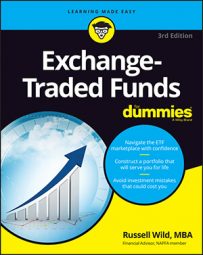Some of the exchange-traded fund (ETF) providers (Vanguard, iShares, Schwab) tend to use traditional indexes, such as the Dow Jones Industrial Average. Others (Invesco PowerShares, WisdomTree, Guggenheim) tend to develop their own indexes.
For example, if you were to buy 100 shares of an ETF called the iShares S&P 500 Growth Index Fund (IVW), you’d be buying into a traditional index (large U.S. growth companies). At about $68 a share, you’d plunk down $6,800 for a portfolio of stocks that would include shares of Apple, International Business Machines, Microsoft Corp, The Coca-Cola Company, Google, Oracle, and Johnson & Johnson.
If you wanted to know the exact breakdown, the iShares prospectus found on the iShares website (or any number of financial websites, such as Yahoo! Finance) would tell you specific percentages: Apple, 5.25 percent; International Business Machines, 3.25 percent; Microsoft Corp, 3.07 percent, The Coca-Cola Company, 2.49 percent; and so on.
Many ETFs represent shares in companies that form foreign indexes. If, for example, you were to own 100 shares of the iShares MSCI Japan Index Fund (EWJ), with a market value of about $10 per share as of this writing, your $1,000 would buy you a stake in large Japanese companies such as Toyota Motor, Honda Motor, Mitsubishi UFJ Financial Group, Canon, and Sony.
Both IVW and EWJ mirror standard indexes: IVW mirrors the S&P 500 Growth Index, and EWJ mirrors the MSCI Japan Index. If, however, you purchase 100 shares of the PowerShares Dynamic Large Cap Growth Portfolio (PWB), you’ll buy roughly $1,700 worth of a portfolio of stocks that mirror a very unconventional index — one created by the PowerShares family of exchange-traded funds.
The large U.S. growth companies in the PowerShares index don’t include Apple, International Business Machines, or Microsoft, but rather companies like Union Pacific, Caterpillar, and Visa. Invesco PowerShares refers to its custom indexes as “enhanced.”
A big controversy in the world of ETFs is whether the newfangled, customized indexes offered by companies like Invesco PowerShares make any sense. Most financial professionals are skeptical of anything that’s new. Those who have been around for a while have seen too many “exciting” new investment ideas crash and burn.
Another big controversy is whether you may be better off with an even newer style of ETFs — those that follow no indexes at all but rather are “actively” managed.
Other ETFs — a distinct but growing minority — represent holdings in assets other than stocks, most notably bonds and commodities (gold, silver, oil, and such). And then there are exchange-traded notes (ETNs), which allow you to venture even further into the world of alternative investments — or speculations — such as currency futures.

